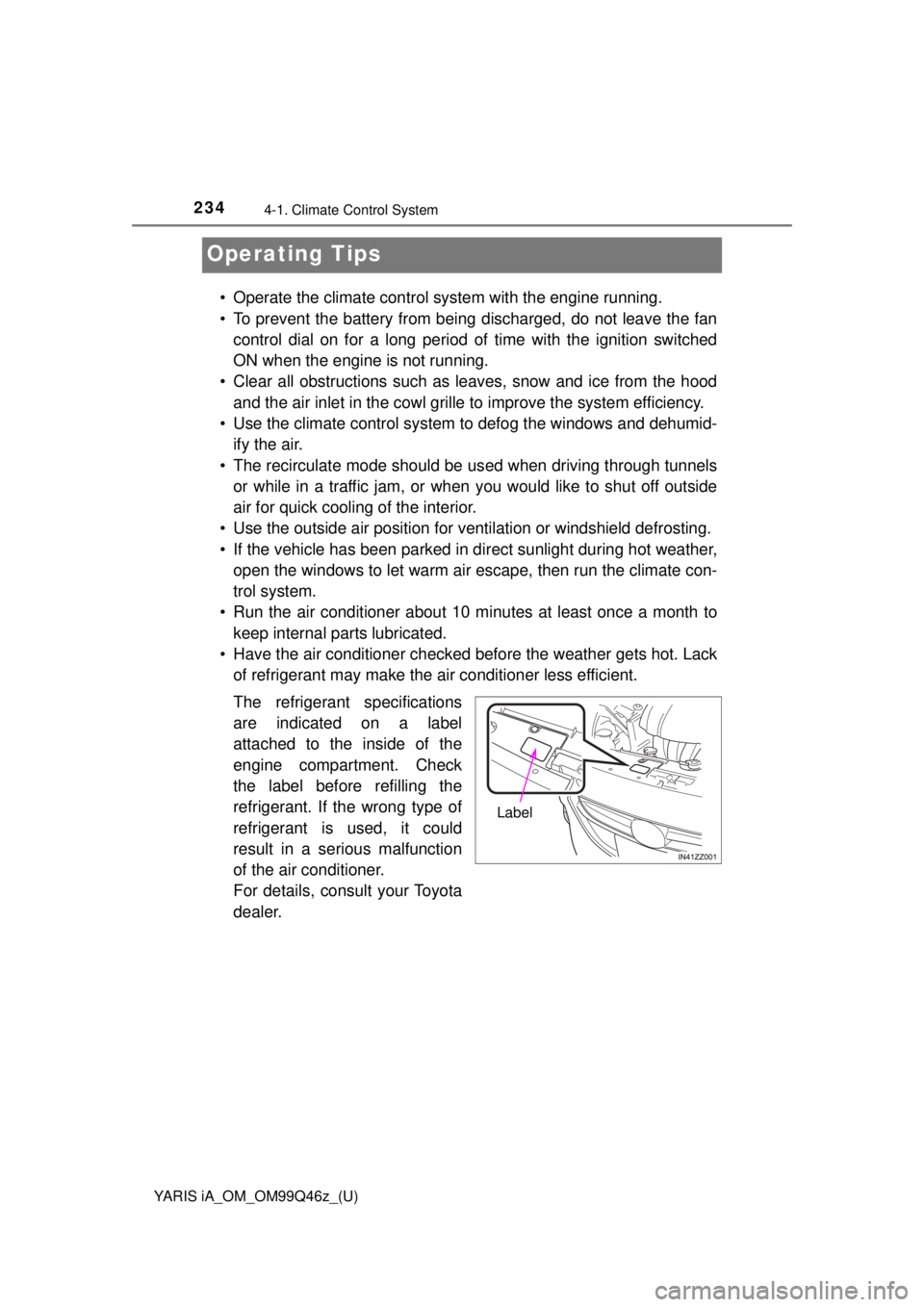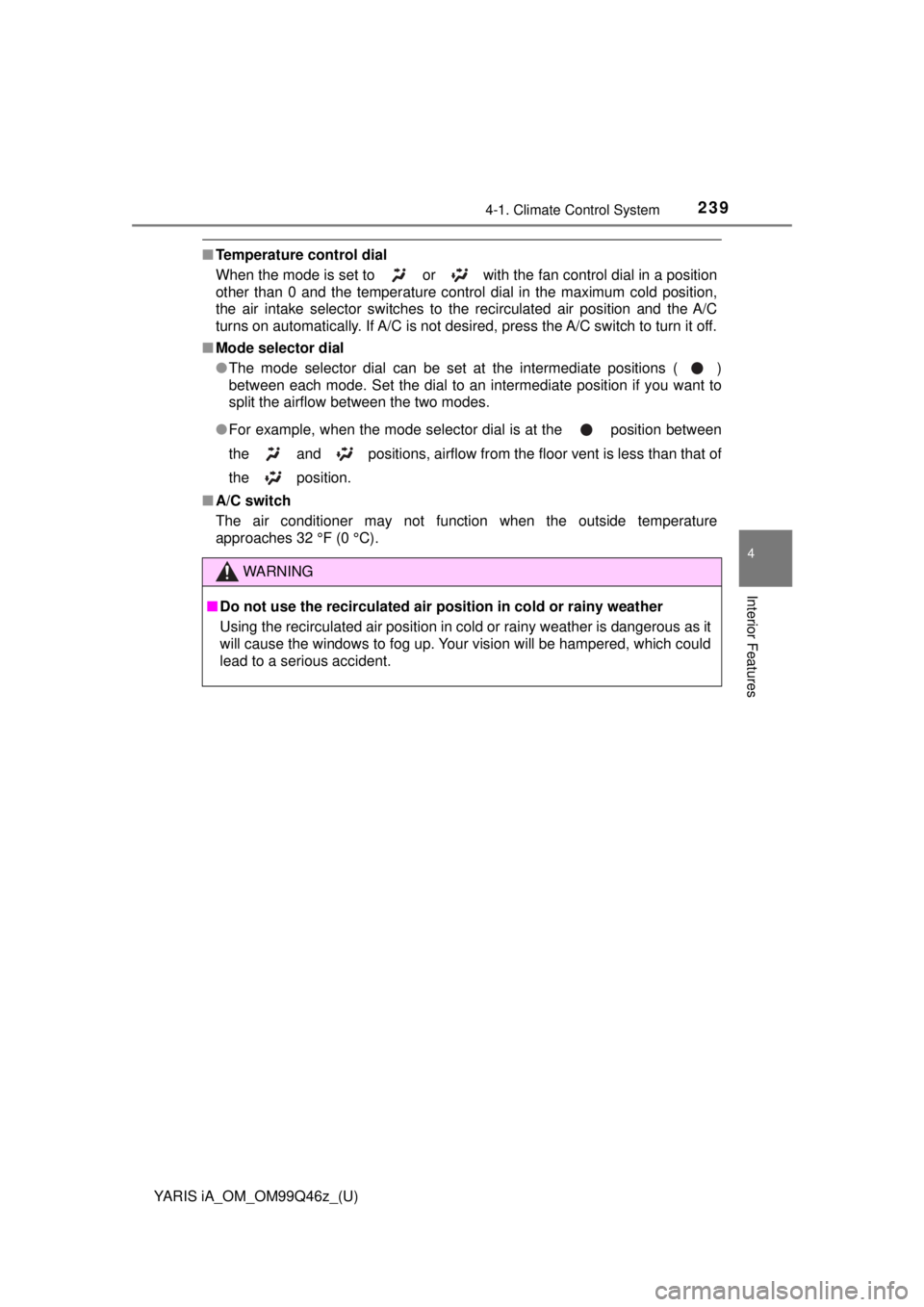Page 130 of 576

130
YARIS iA_OM_OM99Q46z_(U)
2-8. Driving Tips
Winter Driving
Carry emergency gear, including tire chains, window scraper, flares, a
small shovel, jumper cables, a nd a small bag of sand or salt.
Ask your Toyota dealer to check the following: • Have the proper ratio of antifreeze in the radiator. Refer to Engine Coolant on P. 425.
• Inspect the battery and its cables . Cold reduces battery capacity.
• Use an engine oil appropriate for the lowest ambient temperatures that the vehicle will be driven in ( →P. 422).
• Inspect the ignition sy stem for damage and loose connections.
• Use washer fluid made with antifreeze ⎯but do not use engine cool-
ant antifreeze for washer fluid ( →P. 429).
●Do not use the parking brake in freezing weather as it may freeze. Instead,
shift to 1 or R with a manual transaxle and to P with an automatic transaxle.
Block the rear wheels.
● Remove snow before driving. Snow left on the windshield is dangerous as it
could obstruct vision.
● Do not apply excessive force to a window scraper when removing ice or fro-
zen snow on the mirror glass and windshield.
● Never use warm or hot water for removing snow or ice from windows and
mirrors as it could result in the glass cracking.
● Drive slowly. Braking performance can be adversely affected if snow or ice
adheres to the brake components. If this situation occurs, drive the vehicle
slowly, releasing the accelerator pedal and lightly applying the brakes sev-
eral times until the brake performance returns to normal.
Page 139 of 576

139
YARIS iA_OM_OM99Q46z_(U)
3When Driving
3-1. Start/Stop EngineIgnition Switch ................... 140
Starting the Engine ........... 142
Turning the Engine Off ...... 147
3-2. Combination Meter and Display
Meters and Gauges .......... 148
Warning/Indicator Lights .............................. 156
3-3. Transaxle Manual Transaxle Operation ........................ 160
Automatic Transaxle Controls........................... 164
3-4. Switches and Controls Lighting Control ................. 175
Fog Lights ......................... 179
Turn and Lane-Change Signals ............................ 180
Windshield Wipers and Washer..................... 182
Rear Window Defogger ......................... 185
Hazard Warning Flasher ............................ 186
3-5. Brake Brake System .................... 187
Hill Launch Assist (HLA) ... 191 3-6. ABS/TCS/DSC
Antilock Brake System (ABS) .............................. 193
Traction Control System (TCS) .............................. 194
Dynamic Stability Control (DSC) .............................. 196
3-7. Fuel Economy Monitor Fuel Economy Monitor ...... 199
3-8. Drive Selection Drive Selection (Automatic Transaxle) ..... 201
3-9. Power Steering Power Steering ................. 203
3-10. Active Safety System Active Safety System ........ 204
Smart City Brake Support (SCBS)............................ 205
Laser Sensor..................... 211
3-11. Cruise Control Cruise Control ................... 213
3-12. Tire Pressure Monitoring System
Tire Pressure Monitoring System ............................ 218
3-13. Rear View Monitor Rear View Monitor ............ 222
Page 185 of 576
185
YARIS iA_OM_OM99Q46z_(U)
3-4. Switches and Controls
3
When Driving
Rear Window Defogger
The ignition must be switched ON to use the defogger.
Press the switch to turn on the
rear window defogger. The rear
window defogger operates for
about 15 minutes and then turns
off automatically.
The indicator light illuminates
when the defogger is operating.
To turn off the rear window defog-
ger before the 15 minutes has
elapsed, press the switch again.
This defogger is not designed for melting snow. If there is an accumulation of
snow on the rear window, remove it before using the defogger.
To turn on the mirror defoggers, switch the ignition ON and press the
rear window defogger switch (→P. 185).
The rear window defogger clears fog from the rear window.
Indicator light
NOTICE
Do not use sharp instruments or window cleaners with abrasives to clean
the inside of the rear window surface. They may damage the defogger grid
inside the window.
Mirror Defogger (if equipped)
Page 206 of 576

206
YARIS iA_OM_OM99Q46z_(U)
3-10. Active Safety System
●The Smart City Brake Support (SCBS) system will not operate if the driver is
deliberately performing driving operations (accelerator pedal and steering
wheel).
● The Smart City Brake Support (SCBS) system will operate under the follow-
ing conditions.
• The engine is running.
• The Smart City Brake Support (SCB S) warning light (amber) does not
illuminate.
• The vehicle speed is between about 2 to 18 mph (4 to 30 km/h).
• The Smart City Brake Support (SCBS) system is not turned off.
• The DSC is not malfunctioning.
● The Smart City Brake Support (SCBS) detects a vehicle ahead by emitting a
near-infrared laser beam and receiving the beam reflected off the reflector
of the vehicle ahead, and then using it for the measurement. Consequently,
the Smart City Brake Support (SCBS) may not operate under the following
conditions:
• Reflection of the laser is poor due to the shape of the vehicle ahead.
• The vehicle ahead is significantly dirty.
• Under bad weather condition, such as rain, fog and snow.
• The window washer is being used or the windshield wipers are not used
when it’s raining.
• The windshield is dirty.
• The steering wheel is turned completely left or right, or the vehicle is
accelerated rapidly and comes close to the vehicle ahead.
• Trucks with low loading platforms and vehicles with an extremely low or high profile.
• Vehicles with certain shapes such as a vehicle carrier.
● Under the following conditions, the Smart City Brake Support (SCBS) sys-
tem may not operate normally.
• Heavy luggage is loaded in the luggage compartment or on the rear seat.
• If there is the possibility of partial contact with a vehicle ahead.
• When driving on continuously curving roads, and entering and exiting
exits.
• Elongated luggage or cargo is loaded onto installed roof rails and covers the laser sensor.
• Exhaust gas from the vehicle in front, sand, snow, and water vapor rising
from manholes and grating, and water splashed into the air.
• When towing a malfunctioning vehicle.
• When driving with tires having significantly different wear.
Page 234 of 576

234
YARIS iA_OM_OM99Q46z_(U)
4-1. Climate Control System
Operating Tips
• Operate the climate control system with the engine running.
• To prevent the battery from being discharged, do not leave the fan
control dial on for a long period of time with the ignition switched
ON when the engine is not running.
• Clear all obstructions such as leaves, snow and ice from the hood and the air inlet in the cowl grille to improve the system efficiency.
• Use the climate control system to defog the windows and dehumid- ify the air.
• The recirculate mode should be used when driving through tunnels or while in a traffic jam, or when you would like to shut off outside
air for quick cooling of the interior.
• Use the outside air position for v entilation or windshield defrosting.
• If the vehicle has been parked in di rect sunlight during hot weather,
open the windows to let warm air escape, then run the climate con-
trol system.
• Run the air conditioner about 10 mi nutes at least once a month to
keep internal parts lubricated.
• Have the air conditioner checked before the weather gets hot. Lack of refrigerant may make the air conditioner less efficient.
The refrigerant specifications
are indicated on a label
attached to the inside of the
engine compartment. Check
the label before refilling the
refrigerant. If the wrong type of
refrigerant is used, it could
result in a serious malfunction
of the air conditioner.
For details, consult your Toyota
dealer.
Label
Page 237 of 576
237
YARIS iA_OM_OM99Q46z_(U)
4-1. Climate Control System
4
Interior Features
Manual Type
Temperature control dial
A/C switch
Fan control dial
Rear window defogger switchMode selector dial
Air intake selector
(recirculated air position)
Air intake selector
(outside air position)1
2
3
4
5
6
7
Page 239 of 576

YARIS iA_OM_OM99Q46z_(U)
2394-1. Climate Control System
4
Interior Features
■Temperature control dial
When the mode is set to or with the fan control dial in a position
other than 0 and the temperature control dial in the maximum cold position,
the air intake selector switches to the recirculated air position and the A/C
turns on automatically. If A/C is not desired, press the A/C switch to turn it off.
■ Mode selector dial
●The mode selector dial can be set at the intermediate positions ( )
between each mode. Set the dial to an intermediate position if you want to
split the airflow between the two modes.
● For example, when the mode selector dial is at the position between
the and positions, airflow from the floor vent is less than that of
the position.
■ A/C switch
The air conditioner may not function when the outside temperature
approaches 32 °F (0 °C).
WARNING
■Do not use the recirculated air position in cold or rainy weather
Using the recirculated air position in cold or rainy weather is dangerous as it
will cause the windows to fog up. Your vision will be hampered, which could
lead to a serious accident.
Page 243 of 576
YARIS iA_OM_OM99Q46z_(U)
2434-1. Climate Control System
4
Interior Features
Operate the air conditioner in cool or cold weather to help defog the
windshield and side windows.Set the mode selector dial to the desired position.
Set the air intake selector to the outside air position.
Set the temperature control dial to the desired position.
Set the fan control dial to the desired speed.
Turn on the air conditioner by pressing the A/C switch.
One of the functions of the air conditioner is dehumidifying the air and, to use
this function, the temperature does not have to be set to cold. Therefore, set
the temperature control dial to the desired position (hot or cold) and turn on
the air conditioner when you want to dehumidify the cabin air.
Dehumidifying
1
2
3
4
5